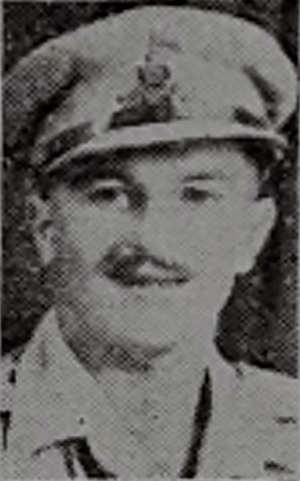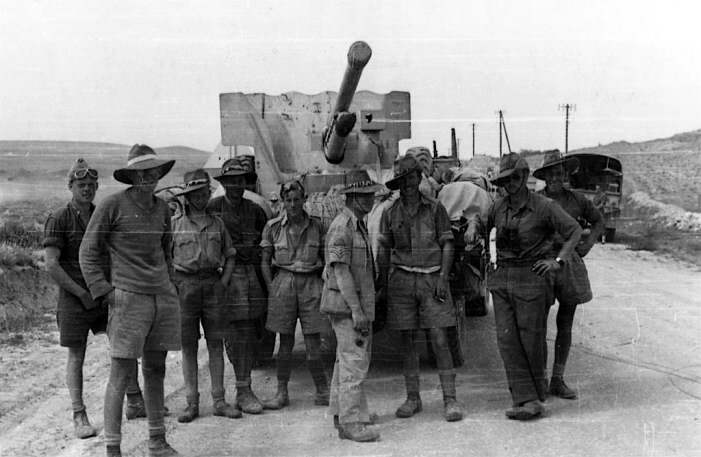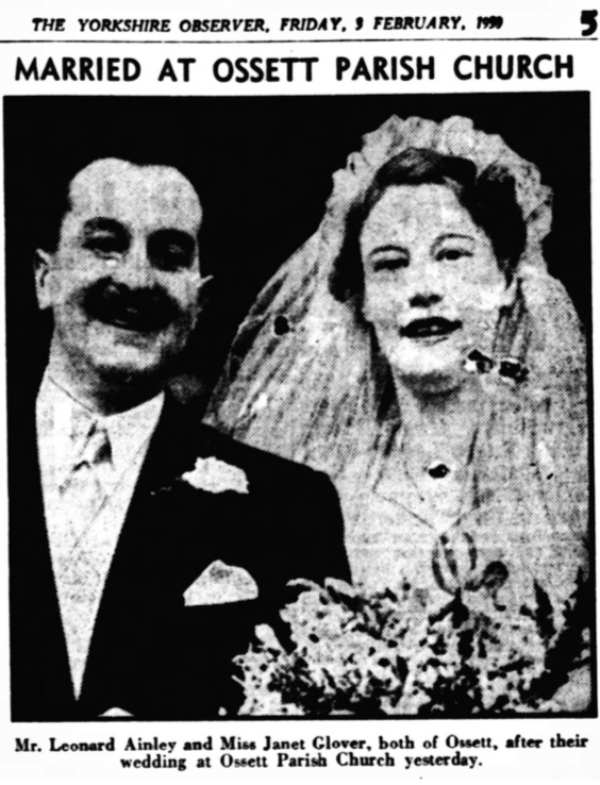 Major Leonard Ainley, MC, TD, 256920, 121 Field Regiment, Royal Artillery
Major Leonard Ainley, MC, TD, 256920, 121 Field Regiment, Royal Artillery
Leonard Ainley was born in Ossett on the 20th November 1916, the eldest son of Richard Ainley and his wife Susan (nee Neil) who married in Huddersfield in early 1906. Richard Ainley served during WW1 as a driver with the Royal Engineers.
Leonard was the eldest of three boys. His younger brothers Willie Ainley, who was born in 1920, and Alexander Ainley, who was born in 1921, were also born in Ossett. Alexander died shortly after birth. At this time Richard and Susan, along with their one year old son Willie, were living at 8, West Wells, Ossett. Richard was unemployed, but had previously worked as a horseman at Newby Hall in Ripon.
Leonard was raised at "The Farm", Mount Pleasant, Roundwood by his grandmother Emma and her second husband, Altofts born farmer, Fred Land. Emma née Shaw and Willie Ainley had married in Almondbury in 1880. Willie was a cattle dealer and the innkeeper of the Tandem Inn, Lepton. He died on December 10th 1899 and Emma took over as licensee. She married 30 year-old farmer Fred Land on April 22 1901 in Kirkheaton and he took over as innkeeper on June 4th 1901 until March 11th 1902.
Before the war Leonard Ainley was a salesman and assistant manager at A.N. Cooke & Co., textile merchants in Dewsbury. He was well known in local golfing and hockey circles and played for the Ossett Cricket and Ossett Rugby Clubs.
Leonard was also a soldier in the Territorial Army and joined up automatically when it was absorbed into the British Army on September 1 1939. He trained in Cairo with the Officer Cadet Training Unit (OCTU) and was commissioned in the Royal Artillery. He was promoted to 2nd Lieutenant in the Royal Regiment of Artillery on the 26th July 1942 when he was 25 years of age.
Lt. Ainley won his Military Cross whilst serving with 121 Field Regiment between the 22nd March 1943 and the 24th April 1943.
In May 1939, the second line, 121 Field Regiment R.A. (T.A.) was formed in Bramley, Leeds. During WWII as part of 49 (West Riding) Division served in Iceland for two years and later, after their return to U.K., took part in the invasion of Normandy in June 1944.
121 Field Regiment went to Iraq in 1941, fought with the 8th Army in North Africa and the American 5th Army in Salerno, Italy in October 1943, before returning to U.K. in November 1943 to take part in the Normandy invasion as a Medium Regiment with 5.5 inch Gun-Howitzers.
At the time of his Military Cross award in 1943, the then Lieutenant Ainley received this citation:
"Throughout the MARETH, AKARIT and ENFIDAVILLE battles, Lt. Ainley has acted on all occasions with conspicuous coolness and courage. His personal example has been an inspiration to his troop. For example, on the 22nd March 1943 at Mareth, the troop positions had two heavy concentrations on it. During the first, a gunner was severely wounded. Lt. Ainley, regardless of his own personal safety, quickly procured a stretcher and helped to carry the casualty to the RAP, whilst the position was still being shelled.
Again, at first light on the 24th April 1943, Lt. Ainley was ordered to occupy an observation post North of Enfidaville on the 2nd New Zealand Division sector. Finding the command unsatisfactory from the FDLs, he moved his observation post forward some 500 yards. The observation post area was being heavily shelled and Lt. Ainley went out on the remote control line on several occasions to repair it.
The above are typical of Lt. Ainley's determination and courageous devotion to duty at all times whilst his Battery was engaged in active operations.
Signed Lt. Colonel M.T.G. Wood, Commanding Officer 121 Field Regiment, Royal Artillery."
The Battle of the Mareth Line or the Battle of Mareth was an attack in the Second World War by the British Eighth Army (General Bernard Montgomery) in Tunisia, against the Mareth Line held by the Italo-German 1st Army (General Giovanni Messe). It was the first big operation by the Eighth Army since the Second Battle of El Alamein 4 1⁄2 months previously. On 19 March 1943, Operation Pugilist, the first British attack, established a bridgehead but a break-out attempt was defeated by Axis counter-attacks.1

Above: British Eighth Army soldiers moving toward the Mareth line in southern Tunisia, March 24, 1943.
The Battle of Enfidaville (19th - 21st April 1943) in Tunisia was the Eighth Army's last significant battle in North Africa, and saw them fail to break through unexpectedly tough Axis resistance in the mountainous terrain around Enfidaville. On the 20th and 21st April 1943 there were heavy counterattacks, led by General Bayerlein, the commander of the German forces in the 1st Italian Army. The British were able to take Takrouna and part of Djebel Garci, twelve miles inland, but at heavy cost. The counterattacks and the heavy losses inland helped convince Montgomery that there was no point going on with the battle. The defenders had a series of strong positions, and were clearly willing to fight to hold onto them. On the 21st April 1943, the Eighth Army attack was suspended, although at that point the plan was to renew the attack along the coast after four days.2

After WW2, Leonard Ainley married Janet Glover (b. 3rd December 1919) in early 1950 at Holy Trinity Church, Ossett, but there don’t appear to have been any children. In 1939, Janet Glover was living with her widowed father, Joseph Glover, a Mungo and Shoddy Manufacturer and two older siblings (Mary and John Glover) at 20, Wesley Street, Ossett. The Ainleys lived at 50A, Wesley Street, Ossett and by 1955, Leonard Ainley had become a Major Ainley, MC, TD, most likely then in the Territorial Branch of the Army.
Leonard Ainley was a frequent visitor to the Boston and New York in the USA between 1956 and 1961, possibly business related or possibly holiday related.
Major Leonard Ainley died in Huddersfield in August 1988 at the age of 71 years, although his postal address was still 50A, Wesley Street, Ossett. He left £165,905 in his Will. His wife Janet died in 1992.
My thanks to Anne-Marie Fawcett for her detailed research into the life and WW2 service of Leonard Ainley.
References: